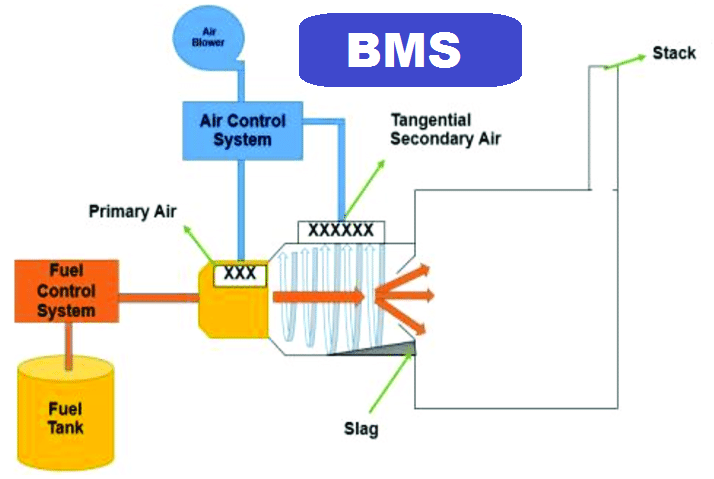What is Burner Management System (BMS)?
- June 25, 2021
- Excel_57
- 0

The energy industry uses various types of direct and indirect fired heaters in the production of oil and gas. Starting up and operating a gas or oil burning heater can introduce a real safety risk to the operation of any facility. One way of controlling this hazard is by installing a Burner Management System (BMS) to your process heater.
The BMS is an engineered hazard control used by oil and gas operators to ensure the safe start-up, operation, and shut down of a process heater. It also helps to save fuel costs, minimize maintenance, improve uptime, and creates a safe environment for the personnel working near the heater. A Burner Management System is also a safeguard to prevent process heaters from exploding in the event of an upset condition.
Components of the Burner Management System
| Components | Purpose |
|---|---|
| Burner | It is where fuel, oil or gas is mixed with air and burned to produce heat. Large heaters often have multiple burners where the combustion process occurs. |
| Controller | A microprocessor used to sequence or control the fuel valves and ignitor(s) of the burner system through the processes that involves purging, ignition, operation, and shut down. |
| Flame Detector | It is a device that helps to sense the absence or presence of a flame and offers a proper signal to detect it. |
| Igniter | It is a device that is permanently installed to provide ignition energy to light the main burner. |
| Valves | Used to control or shut off the flow of gas or oil in the fuel system. |
Functions of the Burner Management System
- Inhibit startup when the conditions are not met
- Monitor the burner to detect unsafe operating conditions
- Protect against unsafe operating conditions
- Shutdown interlocks
When the sensors don’t detect the flame or detects unsafe operating conditions, the BMS signals the actuators to stops the flow of fuel to the burners, to inhibit the flames.
In the industry there are 2 methods for implementing a BMS: Separated or integrated
The separated method is the traditional method of implementing a Safety
Instruments System (SIS) and a basic control system (BPCS). The SIS and BPCS logic solver are separated in two separate equipments.
Also the workstations and the SCADA software for each other are separated. Both systems can communicate with each other using a bus and a common communication protocol.
The integrated method is a new method of implementing the solution. In this method the SIS and BPCS logic solver and workstations are on common equipment. The Logic Solvers is a plc that respects the standards requested by the industry, like SIL3.
- Prevent firing unless a satisfactory furnace purge has first been completed.
- Prohibit start-up of the equipment unless certain permissive interlocks have first been completed.
- Monitor and control the correct component sequencing during start-up and shut-down of the equipment.
- Conditionally allow the continued operation of the equipment only while certain safety interlocks remaining satisfied.
- Provide component condition feedback to the operator and, if so equipped, to the plant control systems and/or data loggers.
- Provide automatic supervision when the equipment is in service and provide means to make a Master Fuel Trip (MFT) should certain unacceptable firing conditions occur.
- Execute a MFT upon certain adverse unit operating conditions
Major Benefits of Burner Management System (BMS)
Safety
Using the BMS can help increase the safety of workers and reduce the chances of
accidents on site.
Eco-Friendly
In addition to protecting from the threat of a natural gas explosion, using a
BMS also helps to reduce greenhouse gas emissions.
Reduced Costs
It helps to minimize the expenses by reducing intervention and shutdown time
and ensuring quick recovery from process upsets. In addition to this, it
requires less maintenance and fewer training requirements to operate it, thus
reducing the overall ownership costs.
Improved Reporting Capability
It helps to simplify the operation of the unit by providing alarm notifications
and sending out operator help messages
Without Using Burner Management System What happen…?
If you do not have a burner management system, the chances of fire and accidents increase. If a pilot flame goes out, the burner gas will flow, despite the absence of proper temperature control. However, this will cause the main burner gas to vent out until you shut it off manually. This creates a very critical situation that can cause damage, proving to be dangerous and expensive.
Types of BMS:
- separate control
- integrated control
An integrated system offers:
- Integrated operating interface
- Integrated fire and gas detection system
- Integrated peer control
- Integrated power supply
- Integrated diagnosis
- Integrated security tools
- Integrated backup and recovery tools
- Integrated post-incident analysis
- Integrated simulation and optimization tools
- Fast data exchange due to direct communication
Advantages:
- Minimize intervention and shutdown time
- Recover more easily from process upsets
- Easier integration of components and systems
- Time synchronization is not needed
- Reduce hardware and installation cost by installing one system instead of two
- Minimize the quantity of spare parts
- Easier and less expensive engineering and maintenance
- Reduce the number of operating personal
- Reduce training requirements and time
- Improve accessibility
If there is a hardware fault, the other system’s in-dependency
keeps it functional.

